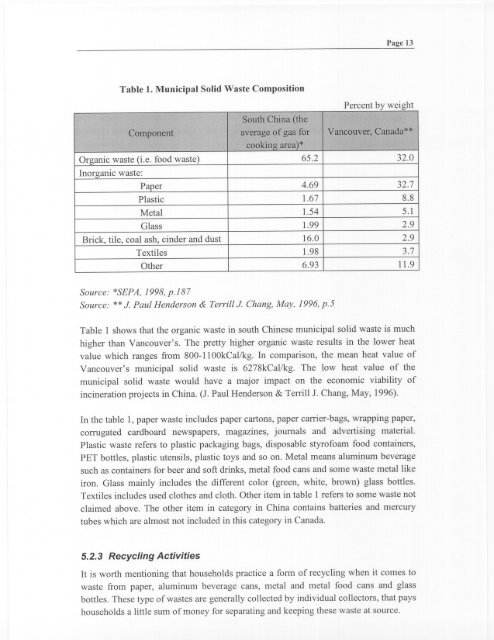a case study of municipal solid waste management in the ... - lumes
a case study of municipal solid waste management in the ... - lumes
a case study of municipal solid waste management in the ... - lumes
Create successful ePaper yourself
Turn your PDF publications into a flip-book with our unique Google optimized e-Paper software.
Page 13Table 1. MunicipalSolid Waste CompositionOrganic <strong>waste</strong> (i.e. food <strong>waste</strong>)Inorganic <strong>waste</strong>:PaperPlasticMetalGlassBrick, tile, coal ash, c<strong>in</strong>der and dustTextilesO<strong>the</strong>r65.2 32.04.6932.71.678.81.545.11.992.916.02.91.983.76.9311.9Source: *SEPA, 1998, p.187Source: ** J Paul Henderson & Terrill J Chang, May, 1996, p.5Table l shows that <strong>the</strong> organic <strong>waste</strong> <strong>in</strong> south Ch<strong>in</strong>ese <strong>municipal</strong> <strong>solid</strong> <strong>waste</strong> is muchhigher than Vancouver's. The pretty higher organic <strong>waste</strong> results <strong>in</strong> <strong>the</strong> lower heatvalue which ranges from 800-1100kCal/kg. In comparison, <strong>the</strong> mean heat value <strong>of</strong>Vancouver's <strong>municipal</strong> <strong>solid</strong> <strong>waste</strong> is 6278kCal/kg. The low heat value <strong>of</strong> <strong>the</strong><strong>municipal</strong> <strong>solid</strong> <strong>waste</strong> would have a major impact on <strong>the</strong> economic viability <strong>of</strong><strong>in</strong>c<strong>in</strong>eration projects <strong>in</strong> Ch<strong>in</strong>a. (J. Paul Henderson & Terrill J. Chang, May, 1996).In <strong>the</strong> table 1, paper <strong>waste</strong> <strong>in</strong>cludes paper cartons, paper carrier-bags, wrapp<strong>in</strong>g paper,corrugated cardboard newspapers, magaz<strong>in</strong>es, journals and advertis<strong>in</strong>g material.Plastic <strong>waste</strong> refers to plastic packag<strong>in</strong>g bags, disposable styro foam food conta<strong>in</strong>ers,PET bottles, plastic utensils, plastic toys and so on. Metal means alum<strong>in</strong>um beveragesuch as conta<strong>in</strong>ers for beer and s<strong>of</strong>t dr<strong>in</strong>ks, metal food cans and some <strong>waste</strong> metallikeiron. Glass ma<strong>in</strong>ly <strong>in</strong>cludes <strong>the</strong> different color (green, white, brown) glass bottles.Textiles <strong>in</strong>cludes used clo<strong>the</strong>s and cloth. O<strong>the</strong>r item <strong>in</strong> table 1 refers to some <strong>waste</strong> notclaimed above. The o<strong>the</strong>r item <strong>in</strong> category <strong>in</strong> Ch<strong>in</strong>a conta<strong>in</strong>s batteries and mercurytubes which are almost not <strong>in</strong>cluded <strong>in</strong> this category <strong>in</strong> Canada.5.2.3 Recycl<strong>in</strong>g ActivitiesIt is worth mention<strong>in</strong>g that households practice a form <strong>of</strong> recycl<strong>in</strong>g when it comes to<strong>waste</strong> from paper, alum<strong>in</strong>um beverage cans, metal and metal food cans and glassbottles. These tyre <strong>of</strong> <strong>waste</strong>s are generally collected by <strong>in</strong>dividual collectors, that rayshouseholds a little stim <strong>of</strong> money for separat<strong>in</strong>g and keep<strong>in</strong>g <strong>the</strong>se <strong>waste</strong> at source.
















